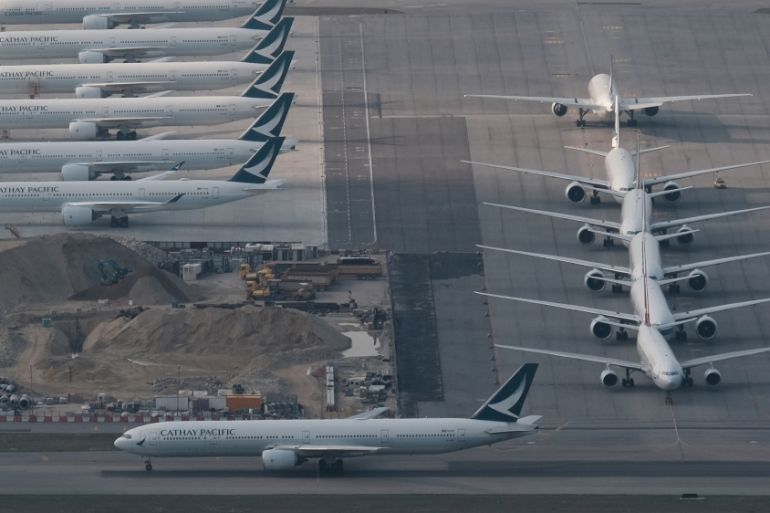Cathay Pacific cuts more flights as CEO, directors take pay cut
The Hong Kong airline’s CEO and chairman will take home 30 percent less pay as the company faces the virus fallout.

Hong Kong’s Cathay Pacific Airways Ltd will make further cuts to passenger capacity because of extremely low demand, leaving it with just two flights a week each to four long-haul destinations in April, according to an internal memo.
The airline carried only 582 passengers one day this week with a load factor of 18.3 percent, which compares with 100,000 customers on a normal day, Cathay chief executive Augustus Tang said in a memo to staff seen by Reuters.
Keep reading
list of 3 itemsAs pressure on airlines grows, many plan to sack, sideline staff
Can airlines survive the coronavirus crisis?
The carrier will maintain a skeleton long-haul network with two weekly passenger flights from Hong Kong to London, Los Angeles, Vancouver and Sydney, while hoping to keep three weekly regional flights to important destinations around Asia such as Singapore, Beijing and Tokyo.
It will also try to capitalise on stronger cargo demand, the memo said.
“However, the reduction of capacity on our wide-body fleet means our cargo revenues are still well below last year,” Tang said.
Most Cathay employees already agreed to take three weeks of unpaid leave as part of an effort to cut costs.
Tang said further unpaid leave in the form of temporary stand-downs and furloughs were occurring in some regions for ground employees where it had stopped flights or reduced capacity.
He will take a 30 percent cut to his base salary from April to December, as will Chairman Patrick Healy, with executive directors taking a 25 percent cut, the memo said.
Globally, analysts expect that the airline industry faces a prolonged recovery as new data showed international fleet capacity had fallen to 23 percent of last year’s levels.
“It is likely that when we get across to the other side of the pandemic, things won’t return to the vibrant market conditions we had at the start of the year,” said Olivier Ponti, vice president at data firm ForwardKeys.
“It’s also possible that a number of airlines will have gone bust and uneconomic discounts will be necessary to attract demand back,” he said in a statement.
ForwardKeys said the number of international airline seats had fallen to 10 million in the week of March 30 to April 5, down from 44.2 million a year ago.
Data firm OAG said several years of industry growth had been lost and it could take until 2022 or 2023 before the volume of flyers returns to the levels that had been expected for 2020.
Cirium, another aviation data provider, said about half of the world’s aeroplane fleet was now in storage.
“While many of these will be temporary storage, many of these aircraft will never resume service,” Cowen analyst Helane Becker said in a note to clients. “We believe the airline industry will look very different when we get to the other side of this.”
Planemakers are looking at drastic cuts in wide-body production amid a slump in demand for the industry’s largest jetliners, manufacturing and supplier sources said.
Deliveries of long-range jets like the Boeing Co 777 or 787 and Airbus SE A350 or A330 have been particularly badly hit as airlines seek deferrals and many withhold progress payments.
British Airways said on Thursday it has struck a deal with its unions to suspend more than 30,000 cabin crew and ground staff in one of the airline industry’s most dramatic moves yet to survive the coronavirus pandemic.